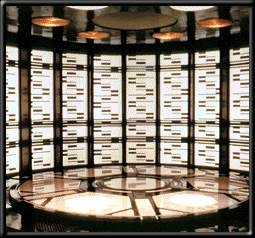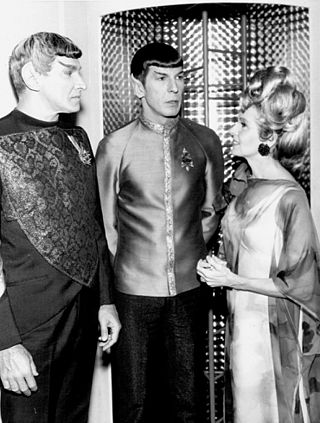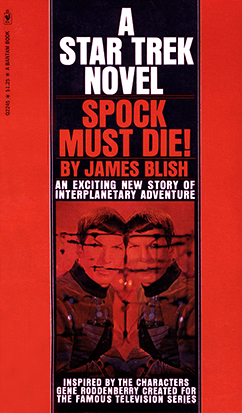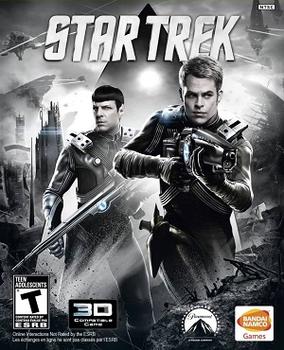Related Research Articles

Star Trek: The Animated Series (TAS) is an American animated science fiction television series created by Gene Roddenberry. It originally aired simply under the title Star Trek, subtitled Created by Gene Roddenberry, on Saturday mornings from September 8, 1973 to October 12, 1974 on NBC, spanning 22 episodes over two seasons. The second series in the Star Trek franchise, it features mostly the same characters as Star Trek: The Original Series. Set in the 23rd century, the series follows the further adventures of the Starship USS Enterprise as it explores the galaxy.

A transporter is a fictional teleportation machine used in the Star Trek science fiction franchise. Transporters allow for teleportation by converting a person or object into an energy pattern, then sending ("beaming") it to a target location or else returning it to the transporter, where it is reconverted into matter ("rematerialization").

Spock is a fictional character in the Star Trek media franchise. He first appeared in the original Star Trek series serving aboard the starship USS Enterprise as science officer and first officer and later as commanding officer of the vessel. Spock's mixed human–Vulcan heritage serves as an important plot element in many of the character's appearances. Along with Captain James T. Kirk and Dr. Leonard "Bones" McCoy, he is one of the three central characters in the original Star Trek series and its films. After retiring from active duty in Starfleet, Spock served as a Federation ambassador, and later became involved in the ill-fated attempt to save Romulus from a supernova, leading him to live out the rest of his life in a parallel universe.

Captain Christopher "Chris" Pike is a fictional character in the Star Trek science fiction franchise. He is the immediate predecessor to James T. Kirk as captain of the starship USS Enterprise.

Sarek is a fictional character in the Star Trek media franchise. He is a Vulcan astrophysicist, the Vulcan ambassador to the United Federation of Planets, and father of Spock. The character was originally played by Mark Lenard in the episode "Journey to Babel" in 1967. Lenard later voiced Sarek in the animated series, and appeared in Star Trek films and the series Star Trek: The Next Generation.
A parallel universe, also known as an alternate universe, parallel world, parallel dimension, or alternate reality, is a hypothetical self-contained plane of existence, co-existing with one's own. The sum of all potential parallel universes that constitute reality is often called a "multiverse". While the six terms are generally synonymous and can be used interchangeably in most cases, there is sometimes an additional connotation implied with the term "alternate universe/reality" that implies that the reality is a variant of our own, with some overlap with the similarly named alternate history.
"Mirror, Mirror" is the fourth episode of the second season of the American science fiction television series Star Trek. Written by Jerome Bixby and directed by Marc Daniels, it was first broadcast on October 6, 1967.
"The City on the Edge of Forever" is the twenty-eighth and penultimate episode of the first season of the American science fiction television series Star Trek. It was written by Harlan Ellison; contributors to and/or editors of the script included Steven W. Carabatsos, D. C. Fontana and Gene L. Coon. Gene Roddenberry made the final re-write. The episode was directed by Joseph Pevney and first aired on NBC on April 6, 1967, with a repeat broadcast on August 31, 1967.
"Assignment: Earth" is the twenty-sixth and final episode of the second season of the American science fiction television series Star Trek. Written by Art Wallace and directed by Marc Daniels, it was first broadcast on 29 March 1968.
"Yesteryear" is the second episode of the first season of the animated American science fiction television series Star Trek. It first aired in the NBC Saturday morning lineup on September 15, 1973, and was written by veteran Star Trek writer D. C. Fontana. Widely regarded as one of the best episodes of the series, it was nominated for a Daytime Emmy Award. "Yesteryear" guest-starred Mark Lenard in the role of Spock's father, Sarek.

"Tomorrow Is Yesterday" is the nineteenth episode of the first season of the American science fiction television series Star Trek. Written by D. C. Fontana and directed by Michael O'Herlihy, it first aired on January 26, 1967. It was the first Star Trek episode to be written solely by a woman.
"The Enterprise Incident" is the second episode of the third season of the American science fiction television series Star Trek. Written by D. C. Fontana and directed by John Meredyth Lucas, it was first broadcast September 27, 1968.

"The Tholian Web" is the ninth episode of the third season of the American science fiction television series Star Trek. Written by Judy Burns and Chet Richards and directed by Herb Wallerstein, it was first broadcast on November 15, 1968.
"All Our Yesterdays" is the twenty-third and penultimate episode of the third season of the American science fiction television series Star Trek. Written by Jean Lisette Aroeste and directed by Marvin J. Chomsky, it was first broadcast March 14, 1969.

Spock Must Die! is an American science fiction novel written by James Blish, published February 1970 by Bantam Books. It was the first original novel based on the Star Trek television series intended for adult readers. It was preceded by a tie-in comic book line published by Gold Key and the novel Mission to Horatius by Mack Reynolds, all intended for younger readers.
"The Jihad" is the sixteenth and final episode of the first season of the American animated science fiction television series Star Trek. It first aired in the NBC Saturday morning lineup on January 12, 1974, and was written by Stephen Kandel who also wrote the earlier story "Mudd's Passion" and worked on the two Original Series "Mudd" episodes.

Space Quest IV: Roger Wilco and the Time Rippers is a 1991 graphic adventure game by Sierra On-Line, and the fourth entry in the Space Quest series. The game was released originally on floppy disks on March 4, 1991, and later released on CD-ROM in December 1992 with full speech support; an Atari ST version was announced via Sierra Online's magazine, Sierra News Magazine, but was later canceled. The game sees players assume the role of Roger Wilco, who is thrust into a new adventure across time and space where he must thwart the plans of an old foe that is seeking revenge against him.

Killing Time is a science fiction novel by American writer Della Van Hise. Part of the Star Trek: The Original Series franchise, it was published by Pocket Books in 1985. The original manuscript had Kirk/Spock slash fiction elements, and these were requested to be removed by Paramount. However, they were not removed, and 250,000 copies were printed. These romantic undertones between Spock and James T. Kirk were brought to the attention of the office of the creator of Star Trek, Gene Roddenberry, who made Pocket Books recall the first edition. This edition subsequently became a collector's item, with more than fifty changes made to a revised version.

Star Trek is a third-person action-adventure Star Trek video game. It was developed by Digital Extremes and co-published by Bandai Namco Entertainment under license by Paramount Pictures in association with CBS Studios International. The game was released in North America on April 23, 2013, for PlayStation 3, Xbox 360, and Microsoft Windows platforms. It took three years to produce, and was the first in-house video game development by Paramount Studios, who opted not to license development to a third party. The production team aimed for it to be a collaboration with those working on the Star Trek films to avoid the typical pitfalls associated with film tie-in video games. Video games which influenced Star Trek included the Mass Effect series, Uncharted and Metroid Prime, and certain elements of Star Trek reflected episodes of Star Trek: The Original Series such as "Arena" and "Amok Time".
Suspended animation in fiction refers to the temporary cessation of life processes experienced by fictional characters, followed by their subsequent revival. This process is commonly employed as a plot device in science fiction narratives. It is frequently utilized to transport a character from the past to the future or to facilitate interstellar space travel, which necessitates an extended journey for months or years. In addition to accomplishing the character's primary objective in the future, they often encounter the unfamiliarity of a new world, which may bear only faint resemblance to their previous surroundings. On occasion, a character is portrayed as possessing skills or abilities that have become lost to society during their period of suspension, enabling them to assume a heroic role in their new temporal setting.
References
- ↑ "The BEST episodes of Prehistoric Park". episode.ninja. Retrieved 2024-02-28.